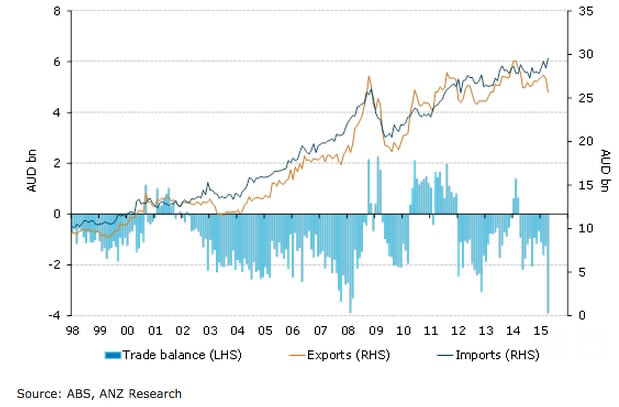Australian Dollar Lower Following Trade Deficit Data Disappointment
The British pound to Australian dollar exchange rate conversion (GBP-AUD) has risen to 1.1931 following a number of negative Aussie economic data releases.
The move higher in the GBP-AUD keeps alive our forecasts for levels above 2.0 to become the norm towards the latter part of 2015.
The Aus dollar also suffered against the US dollar; AUDUSD fell sharply from 0.7780 to 0.7779 on weak retail and trade balance data.
April retail sales remained flat against exceptions for a 0.3% increase while the trade deficit widened to A$3,888mil as imports outstripped exports.
Imports rose 4.00% as the value of industrial equipment, machinery rose and oil increased.
“However, worryingly for Australia, and regional export driven economies, there is evidence that demand weakness is growing. Australian exports fell by 6.00% in April led by weakness in commodity prices and demand,” notes Peter Rosenstreich, Chief FX Analyst at Swissquote Bank.
Adding to the Australian dollars woes are signs that any hope for a recovery in commodity prices is unlikely to materialise soon.
BHP Billiton chief executive Andrew Mackenzie told a meeting of senior executives and politicians in Australia that incremental supply, induced during periods of higher prices, will take longer to absorb and this means over-supply may persist for some time keeping commodity prices under pressure.
The comments appear to relate to the slowdown in growth in China and the impact on demand growth for commodities in general. This is important for the Australian dollar and economy - the RBA may well have to cut interest rates again in coming months to ensure that the non-mining sector is given the stimulus needed to ensure it can grow and pick up the slack left by the declining mining sector.
Any sniff of a further interest rate cut will surely push the Australian dollar exchange rate complex yet lower.
Rob Rennie at Westpac, in a currency forecast note out on Friday, points out "falling commodity prices are squeezing income of our households, our business and exporters and our government. This is a story that will continue."
"We maintain a negative bias for the A$, but given the recent volatility, this is a mild negative bias. We still expect the run of event risk in June to drive the currency lower, but are only targeting a low (in AUD v USD) around 0.75/ 0.7550 in the weeks ahead. Beyond that, much will depend on the FOMC in two weeks. Beyond this, we maintain a year end forecast of 0.73," says Rennie.
Note that these rates refer to the wholesale markets and when you make an international payment / transfer your bank will charge a spread at their discretion. However, using an independent currency provider will get you closer to the real market rate as they apply a smaller spread, in some instances this results in up to 5% more FX being delivered and no fees being charged, find out more.
Worrying Trade Deficit
Australia is also in desperate need of a lower exchange rate in order to stimulate its exports.
Australia’s trade deficit widened to the largest deficit on record in April. Lower exports drove 60% of the deterioration, with lower resources exports the key contributor.

There were some positives though as manufacturing exports are trending higher.
Imports were up 3.9% m/m, partially reflecting higher oil prices. “Looking ahead, weakness in commodity prices is likely to keep the trade balance in deficit until the end of 2015,” says Katie Hill at ANZ Bank.
The RBA is well aware of the need for a lower exchange rate - the question now becomes whether or not it believes current interest rates are too high. A cut could well push the AUD lower and give exporters some breathing space. We do however caution that they may take note of the trend higher in manufacturing exports and could well watch to see whether this trend warrants a cut.
It is worth noting that tourism related services imports and exports both rose modestly in April. More broadly, net spending on tourism has improved in the last two years due to the lower AUD.




